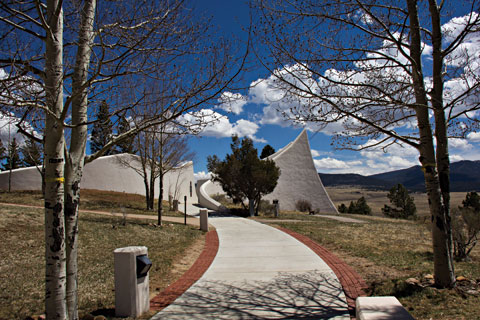 |
||||||||||||
|
May/June 2014
BY LOANA HOYLMAN
This memorial is all light and flight compared to the darkness of the Vietnam Veterans Memorial in Washington, D.C. The war was dark and tragic, the deaths darker still. The Washington Memorial is like a forest, “lovely, dark, and deep.” It captures the names in granite—immoveable, emotional, and ever still. It is a bivouac, a refuge, a gathering place of souls. The Angel Fire Memorial is all white on dark hills, rising on a sloping cliff, ready to take off. It is all light ready to ascend, as if the damaged and the dead are being set free to fly, singing as they rise. The Wall is a lamentation. Angel Fire is a song of freedom. It is a solitary place of peace. Inside this building is a chapel, appropriately called the Peace and Brotherhood Chapel. The memorial was built by Victor and Jeanne Westphall, together with their second son, Walter. Their eldest, Marine First Lt. David Westphall, was killed with sixteen other men in an ambush in Con Thien in 1968. The Westphalls used the money from their son’s insurance policies to build Angel Fire, the first Vietnam veterans memorial. Dr. Westphall later visited Con Thien, and spread soil from Angel Fire on the ground.
The Visitor Center displays banners and photographs from units that served in Vietnam. People still bring and mail photographs from the Vietnam War. They are quickly inventoried and displayed. There is also an 86-minute documentary movie called America: Letters Home from Vietnam by Robin Michael. The Veterans Room is about soldiers killed or missing during the war. A small statue of clenched hands bound together represents POWs. A library and gift shop are also inside. A Vietnam War Huey helicopter sits next to the building. Named the Viking Surprise, it was hit by 135 bullets, returned home, then sent back to Vietnam, and then to the New Mexico National Guard. The Guard gave it to Angel Fire.
One of the most moving outside features is a series of dark red plaques set flush with the ground that list the names of veterans. The garden on the grounds is another symbol of peace and quiet; comfortable benches encourage the contemplation of the garden and the encircling hills, forests, and meadows. In every season, the site is breathtaking. This building, this land, is sacred. You feel it the minute you step out of your vehicle. There are several places to stay in the tiny nearby village of Eagle Nest and in the resort town of Angel Fire. Or you can stay in Taos, an easy and scenic drive from the memorial. In Eagle Nest, the food is not great. But in Angel Fire itself, Hatcha on the main road has good, inexpensive New Mexican food, good hamburgers, and great fries. It features wooden booths and an outside dining area. There are a couple other small places that serve good sandwiches. Taos is a much larger town in the northern mountains of New Mexico. There are scores of art galleries, stores of every kind, and expensive and inexpensive places to eat and stay. The hotels and motels range from Motel 6 to upscale places in the historic district. The campgrounds nearby are excellent. The closest is Cimarron Canyon with several camping sites along a narrow, stunning canyon of trees and water, including a fishing lake. Along the Enchanted Circle are other campgrounds, some beautiful, some not. You can also camp in several pleasant places on the road to the ski area. The drive to the ski area is well worth the time, any time of year. There are many restaurants in Taos, some very expensive, others not so much. There’s a good deli, the Taos Deli, on Bent Street, with great food and affordable prices, sandwiches to full dinners, with an amazing beer list. You can sit inside or outside. Sometimes there is live—and very good—music. The little shopping area around the restaurant is great. So is the bookstore, Moby Dickens, across from the deli, which carries many books of local interest. Between the stores is a walkway where you will always find people with dogs, a small fountain, places to sit, and live music. If you like rocks and minerals, stop at Taos Gems and Minerals at the south end of town. The people are friendly and knowledgeable, and the jewelry and freestanding rocks and minerals are beautiful with the best prices in northern New Mexico. There are also shops with stunning fabrics, shops with products from all over the world, spiritual centers, Catholic churches old and new, and shops selling authentic Indian jewelry, rugs, and other art. If you’ve never seen an American Indian pueblo, be sure to visit the Taos Pueblo. It is the oldest continuously inhabited village in the United States. The multistory buildings are all adobe. You can buy Taos jewelry and other art at the pueblo store. No photos are permitted. There are eighteen other pueblos in New Mexico, as well as Apache and Navajo reservations. Angel Fire sits on a little spur off a highway loop called the Enchanted Circle. You can drive the loop in a couple hours. Every mile is gorgeous, and most of it is without buildings or people. There are many places you can get out, walk, and explore the landscape, rock hound, hike, sit, and grin. It is a photographer’s dream. If you go: The Visitor Center is open from 9-5 every day of the week, though you can walk around the memorial grounds at any time, day or night. To contact the memorial, write to New Mexico State Parks, P.O. Box 608, Angel Fire, NM 87710; phone 575-377-6900; or visit the website, www.vietnamveteransmemorial.org
|
||||||||||||
|
|
||||||||||||
|
||||||||||||
8719 Colesville Road, Suite 100, Silver Spring. MD 20910 | www.vva.org | contact us |
||||||||||||








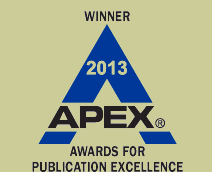

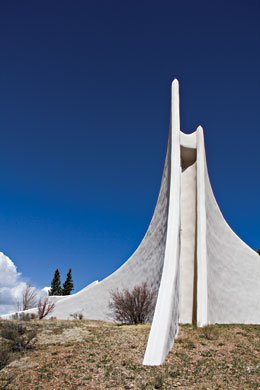 White wings sail along sweeping lines, ethereal, solid. Angel Fire Memorial is a white eagle. It is the prow of a ship taking off into perfect skies—dark or fair. This day the sky is dark blue. The white of the building glows like the full moon. Tall ponderosa pines with their cinnamon bark and butterscotch fragrance dot the landscape and shadow the Huey parked on a rise of land. The surrounding hills echo the sweep of the memorial. Pine and spruce forests, dark in the distance, emphasize the brightness of the white eagle perched on a hill at 8,500 feet in Angel Fire, New Mexico.
White wings sail along sweeping lines, ethereal, solid. Angel Fire Memorial is a white eagle. It is the prow of a ship taking off into perfect skies—dark or fair. This day the sky is dark blue. The white of the building glows like the full moon. Tall ponderosa pines with their cinnamon bark and butterscotch fragrance dot the landscape and shadow the Huey parked on a rise of land. The surrounding hills echo the sweep of the memorial. Pine and spruce forests, dark in the distance, emphasize the brightness of the white eagle perched on a hill at 8,500 feet in Angel Fire, New Mexico. 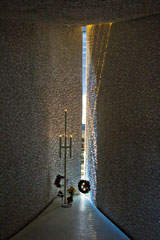 Today, Angel Fire is a New Mexico State Park. There is no fee. The memorial was designed by a young sculptor from Santa Fe, Ted Luna. To have built this memorial at a time when the war was unpopular, 1968-71, took courage and dedication. After devoting his last years to the memorial and its visitors, Victor Westphall died in 2003. His memorial service was held at Angel Fire, where he is buried alongside his wife.
Today, Angel Fire is a New Mexico State Park. There is no fee. The memorial was designed by a young sculptor from Santa Fe, Ted Luna. To have built this memorial at a time when the war was unpopular, 1968-71, took courage and dedication. After devoting his last years to the memorial and its visitors, Victor Westphall died in 2003. His memorial service was held at Angel Fire, where he is buried alongside his wife. 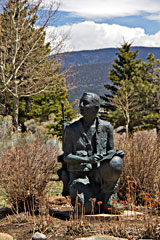 Nearby is a statue by New Mexico sculptor Doug Scott of a soldier writing a letter to his parents, his rifle slung over his shoulder. He represents thousands, but one thinks of David Westphall. Another statue, a copy of the Vietnam Women’s Memorial by Glenna Goodacre (another New Mexico sculptor), stands outside as well.
Nearby is a statue by New Mexico sculptor Doug Scott of a soldier writing a letter to his parents, his rifle slung over his shoulder. He represents thousands, but one thinks of David Westphall. Another statue, a copy of the Vietnam Women’s Memorial by Glenna Goodacre (another New Mexico sculptor), stands outside as well. 